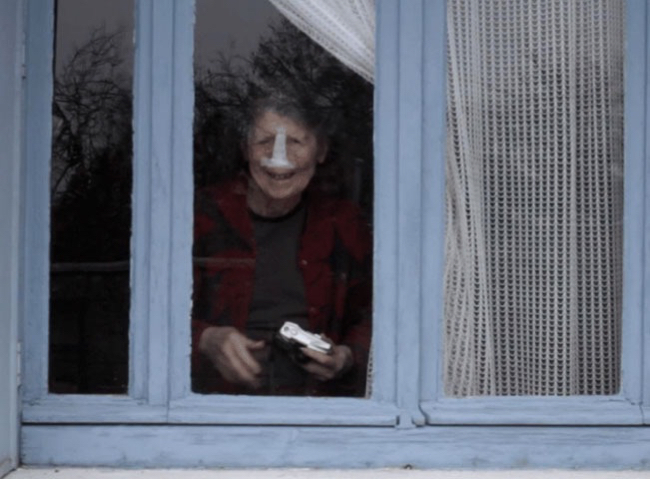Dans l'œil du chien
-
Réalisé par Laure Portier • Écrit par Laure Portier
-
France, Belgique • 2019 • 38 minutes • Couleur
- Réalisation :
Laure Portier - Écriture :
Laure Portier - Image :
Laure Portier - Son :
Zied Mokaddem - Montage :
Julie Brenta
- Production (structure) :
Perspective Films - Coproduction :
Stempel Films - Ayant droit :
Perspective Films
- N° ISAN :
non renseigné
Résumé
La grand-mère, qu’un premier plan sans fard montre assise sur son canapé dans un ronron de frigo, voûtée sous le regard têtu du film, chassant de rares mouches pour soulager le malaise que lui coûte la caméra, la grand-mère, donc, est malade. C’est une maladie qui lui mange le visage : comme si, petit à petit, elle s’effaçait. Et si la petite fille filme, c’est évidemment pour embaumer dans l’image la grandmère qui va mourir. Mais d’une façon qui donne l’impression que le film voudrait lutter contre la maladie à armes égales, en cannibale. C’est un portrait littéralement dévorant, qui va chercher au fond des draps et des pèlerines l’odeur chaude de la vie persistante, toucher par la main de la petite fille celle de la grand-mère à la peau quasi-translucide, regarder à s’user l’oeil le visage dont la blessure, à force de regard, s’oublie. Cette blessure est pour la cinéaste une question entêtante, et la mort à travers elle une énigme charnelle, dans laquelle il faut plonger les deux mains. C’est ce que dit, avec autant de brutalité que de noblesse, une scène admirable où Eustache revient deux fois (par la grand-mère, par le cochon), Eustache auquel on pense ici presque autant qu’à Pialat. Car tous deux savaient, comme le sait Laure Portier face à sa grand-mère, qu’il faut être cru pour aimer, et qu’on ne réussit un geste d’amour comme Dans l’œil du chien qu’à la condition de ne pas retenir la cruauté de son regard. Prince, le chien, n’a pas cette chance: dans son oeil fidèle, la mort est la plus aveuglante des énigmes.
(Jérôme Momcilovic)
The grandmother shown in the candid opening shot is seated on her sofa to the humming of a refrigerator, hunched under the film’s obstinate gaze, swatting the odd fly to ease the discomfort caused by the camera. The grandmother is in fact ill. A disease is eating away her face as if she were gradually disappearing. And if the granddaughter is filming, it is clearly in order to embalm her dying grandmother in images. But the way she goes about it gives the impression that the film wants to fight the disease on equal terms, as a cannibal. This literally devouring portrait seeks the warm odour of persistent life under sheets and capes, uses the granddaughter’s hand to touch the grandmother’s hand and its almost translucid skin, relentlessly watches the face whose wound is forgotten by dint of looking. For the filmmaker, this wound is a compelling question and, through it, death becomes a physical puzzle into which you need to plunge both hands. This is what is said, with as much brutality as nobility, in an admirable scene twice revisited by Eustache (via the grandmother, via the pig), who comes to mind here almost as much as Pialat. Both of them knew, as does Laure Portier facing her grandmother, that you have to be raw to love, and a gesture of love like Dans l’œil du chien can only succeed if the cruelty of one’s gaze is not restrained. Prince, the dog, is not as lucky: in his faithful eye, death is the most blinding of all puzzles.
(Jérôme Momcilovic)
Mot(s)-clé(s) thématique(s)
Sélections et distinctions
- 2019 • Images en bibliothèques • Paris (France) • Film soutenu par la Commission nationale de sélection des médiathèques
- 2019 • Les Rencontres du film documentaire de Mellionnec • Mellionnec (France) • Sélection
- 2019 • Côté court - Festival du film court de Pantin • Pantin (France) • Sélection Panorama
- 2019 • Cinéma du réel • Paris (France) • Prix du court métrage


